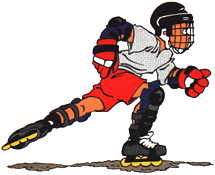HOCKEY 101: Training Drills
Skating Drills
by Andria Hunter

Balance
- Drill: Set up stick and spin
- Drill: Pass stick between partners and spin
Starts
- V start
- Sideways start - push off on near skate, take three quick strides before you start with your regular extended skating stride. These are called "toe starts"
Forward Skating
- stay low
- keep knees bent - but don't bend your back way over forwards
- full extension with each stride
- don't bring legs back in a circle - when your skate comes out to the side at the end of the push, bring it back in a straight line
- bring skates back as close to the middle as possible
- keep stick in front and on the ice
- thrust ankle at the end of each stride (swoosh sound)
- minimize the extraneous side-to-side movement - do not "row the boat" - do not involve your upper body when you skate - keep motion going forwards, not side-to-side - drill: try skating while carrying a puck on your stick (at waist level). If you swing as you skate, the puck will fall off the stick. Keep your upper body still. Skate from the waist-down, and play hockey from the waist-up!
Forwards to Backwards Transition
6/12 drill: skate around the circles, but always face towards the same end of the arena (skate both directions around circles)
Changing from forwards to backwards skating just takes a lot of practice. You might try leaning a little on your stick if you're having trouble balancing on the transition. If it's still really difficult, perhaps you can balance by holding onto someone. Start by leaning a lot on the other person, and as you get the feel of it, gradually decrease your dependence on the other person.
One of the drills that we do is called the 6 and 12 drill. In this drill you skate around the large faceoff circles which are painted on the ice, but keep facing towards one end of the ice at all times. This will be very difficult until you get the hang of it. You probably want to just start practicing the transition while skating in a straight line, but if you can get to the point where you can do it while going around the circles, you'll be well on your way to mastering the transition. Once you get really good at it, try doing it with a puck!
The way that you skate in this drill simulates how you should keep facing the puck during a game of hockey. Instead of turning your back on the play, practice skating so that the puck never leaves your view. This makes it much easier for teammates to pass you the puck, and for you to always know where the puck is.
This drill is called the 6 and 12 drill because you rotate from backwards to forwards at 6:00 and from forwards to backwards at 12:00 (if the circle was a big clock). Practice skating in both directions around the circle, as people often tend to favour crossovers in one direction.
Cross-overs
- stay low
- keep knees bent
- hopping
- push out with inside skate when you step over
- lift outside leg over o work on making really tight circles
- keep stick in front and on the ice
- drill: three quick crossovers in either direction
- drill: skate forwards around the circles (skate both directions around circles)
Stopping
- keep skating until the stop (don't slow up until you actually want to make the stop)
- keep bent until the stop
Backwards skating
- keep low
- knees bent
- balance
- drill: three quick crossovers in either direction
- drill: skate backwards around the circles (skate both directions around circles)
- 6/12 drill: skate around the circles, but always face towards the same end of the arena (skate both directions around circles)
Cornering and tight turns
- absolutely do not "ski" around corners -- extremely, extremely important! By not skiing (planting both edges of the skates), it improves your maneuverability. Do not get both edges leaning the same way, as it harder to change direction.
- keep both inside edges planted so that you can change direction easily. If you commit to the outside edge, it's hard to change directions. If you make it so that either edge can be planted, it keeps the person covering you guessing. It's much harder for her to anticipate your next move.
- drill: skating around pilons which have been placed in a zig-zag pattern. Do not use the outside edge of the inside skate as you go around the pilons. Use the inside edge of the outside skate.
General Skating Tips
- Full leg extention with each stride.
- Bring each leg back to the center position.
- Bring each leg back in a straight line, and as quickly as possible. Do not bring your legs back in a big arc.
- You must have proper bend at the knees and ankles; don't tighten the top of your skates too much. As you extend your leg and push off, "snap" your ankle for additional power.
- Use "toe starts" to get a quick start. Explode as you take off by "running" a few steps on the front inside edges of your skates. Keep your skates in the "V" position. As you excelerate, move horizontally, not vertically.
- Keep only the top hand on the stick as you skate if you are on a breakaway or if you are skating a long stretch without the puck. This allows you to go your fastest. Keep your stick on the ice so that you are ready if the puck should come in your direction.
« Back to Hockey 101

